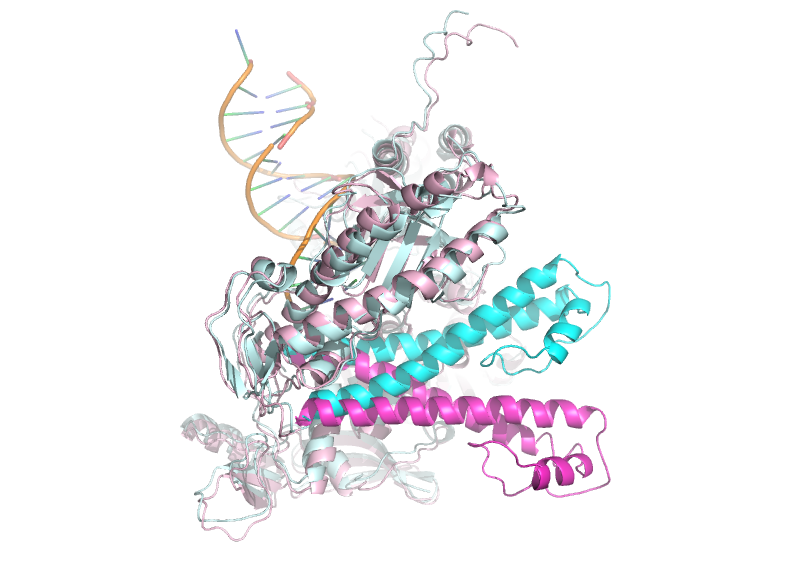User:Karl E. Zahn/Sandbox RB69 1/fingers-domain
From Proteopedia
| (One intermediate revision not shown.) | |||
| Line 1: | Line 1: | ||
[[Image:1IG9 1WAJ fingers.png]] | [[Image:1IG9 1WAJ fingers.png]] | ||
| - | The <scene name='User:Karl_E._Zahn/Sandbox_RB69_1/fingers-domain/Fingers/1'>fingers domain</scene> of RB69 DNA pol exist as an insertion between the two sequences forming the palm. Since the fingers domain experiences a 60 degree rotation from the open or apo structure to the closed catalytically competent structure, the fact that the palm flanks the fingers in primary sequence is likely required for proper communication between these domains. The fingers domain also provides important <scene name='User:Karl_E._Zahn/Sandbox_RB69_1/fingers-domain/Nucleotide-binding/1'>basic residues</scene> that bind triphosphates. K561 is also believed to stabilize the pentacovalent intermediate formed with nucleophilic attack of the 3'-OH on the alpha phosphate<ref>PMID:11389835</ref>. | ||
| - | |||
<applet load='Insert PDB code or filename here' size='300' frame='true' align='right' caption='The fingers domain of gp43 encodes basic residues required for nucleotide binding and full catalytic efficiency' scene='User:Karl_E._Zahn/Sandbox_RB69_1/fingers-domain/Fingers/1' /> | <applet load='Insert PDB code or filename here' size='300' frame='true' align='right' caption='The fingers domain of gp43 encodes basic residues required for nucleotide binding and full catalytic efficiency' scene='User:Karl_E._Zahn/Sandbox_RB69_1/fingers-domain/Fingers/1' /> | ||
| + | |||
| + | The <scene name='User:Karl_E._Zahn/Sandbox_RB69_1/fingers-domain/Fingers/1'>fingers domain</scene> of RB69 DNA pol exist as an insertion between the two sequences forming the palm. Since the fingers domain experiences a 60 degree rotation from the open or apo structure to the closed catalytically competent structure, the fact that the palm flanks the fingers in primary sequence is likely required for proper communication between these domains. The fingers domain also provides important <scene name='User:Karl_E._Zahn/Sandbox_RB69_1/fingers-domain/Nucleotide-binding/1'>basic residues</scene> (K560, K486, R482) that bind triphosphates. K560 is also believed to stabilize the pentacovalent intermediate formed with nucleophilic attack of the 3'-OH on the alpha phosphate<ref>PMID:11389835</ref>. | ||
| + | |||
| + | An additional role, potentially under investigated at this time is the role of the fingers domain in stabilizing the template DNA strand. The residue <scene name='User:Karl_E._Zahn/Sandbox_RB69_1/fingers-domain/W574/1'>W574</scene>provides stacking interactions upstream of the templating position. | ||
| + | |||
| + | ==References== | ||
| + | |||
| + | <references /> | ||
Current revision
|
The of RB69 DNA pol exist as an insertion between the two sequences forming the palm. Since the fingers domain experiences a 60 degree rotation from the open or apo structure to the closed catalytically competent structure, the fact that the palm flanks the fingers in primary sequence is likely required for proper communication between these domains. The fingers domain also provides important (K560, K486, R482) that bind triphosphates. K560 is also believed to stabilize the pentacovalent intermediate formed with nucleophilic attack of the 3'-OH on the alpha phosphate[1].
An additional role, potentially under investigated at this time is the role of the fingers domain in stabilizing the template DNA strand. The residue provides stacking interactions upstream of the templating position.

